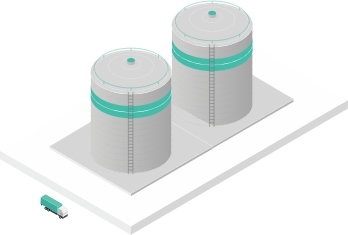When purchasing a new storage tank, companies often have a tendency to train their focus on the sales price (capital expenditure/CAPEX). However, in reality, other related costs also need to be taken into account to determine the overall lifecycle costs. These include, for example, the operating (OPEX), replacement and disposal costs for stainless steel or duplex. These additional aspects put the long-term profitability potential of your storage tank into a completely new light. Tank storage is big business and its importance will only increase in the future, so even more reason to focus on reducing costs and investing in assets that provide greater value for money. When you invest in new storage tanks therefore, you should opt for construction materials which give you the lowest lifecycle costs and are versatile in their usage.
Reducing costs and get the most out of your tanks
At Gpi Tanks XL we construct tanks made exclusively from the highest stainless steel or duplex grades. This enables us to supply high-strength, corrosion-resistant tanks. Meanwhile, you enjoy benefits, such as lower lifecycle costs (reducing costs) and greater storage flexibility.
Price stability: stainless steel versus duplex
Compared with austenitic stainless steel, duplex grades contain more chromium and nitrogen, and less molybdenum and nickel. Austenitic stainless steel, however, still offers a comparable level of corrosion resistance. Prices for nickel and molybdenum are notoriously unpredictable. Prices for duplex grades on the other hand, have the advantage of being significantly more stable.
Due to their low nickel content, lean duplex stainless steels enjoy greater price stability. The price of nickel, for example, rose from 15,000 to 50,000 US dollars per ton in 2008, before dropping once again. The market became subject to significant turbulence, so manufacturers, users and stockholders started looking elsewhere for more preferable price-stable options.
Reducing costs in a tank’s life: a sustainable choice
Stainless steel, like duplex, offers advantages not only in terms of material costs, assembly, manufacturing and transportation. But in addition, no internal and/or external surface treatment is required in its application, in contrast to, for example, carbon steel tanks. What’s more, stainless steel retains its value, as the recycling rate at the end of a tank’s life averages more than 90%.
Stainless steel tanks are likewise suitable for the storage of new, alternative energy carriers. Thus addressing more effectively the switchover to more sustainable products needed in the face of climate change.
Additional reasons for choosing duplex
Due to its strength, the application of duplex can significantly reduce the quantity of material used in tank construction, in turn leading to lower costs. Our white paper on duplex presents calculation models relating to the total cost of ownership, and how to reduce costs when purchasing a stainless steel/duplex storage tank.
Does all this really stack up in practice?
A growing number of tank and terminal operators are experiencing the benefits of stainless steel and/duplex, not least because of the lower lifecycle costs. Why not give us the chance to demonstrate this using a number of customer cases? In our white paper ‘Reducing costs’ we provide three examples of how duplex stainless steel can be used in tank construction. We will be more than happy to present additional case studies on request. Or give you a more precise quotation based on your specific individual needs.

Your enquiry online in three easy steps
Prefer to have your tanks constructed in our plant and shipped or assembled right there on site? Please follow the simple step-by-step process that we have set up to help you with your enquiry.